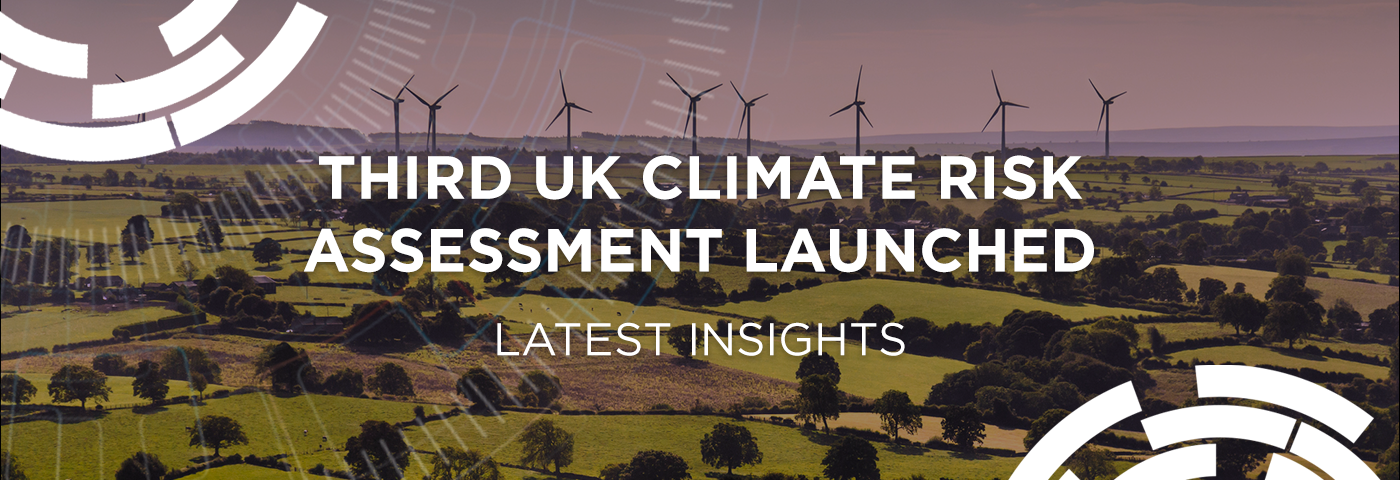Third UK climate risk assessment launched
Make time to watch the Climate Change Committee’s thought – and hopefully action – provoking video. This launched their Third UK Climate Risk Assessment (CCCRA3) last week and concludes that progress in adaptation policy and implementation is not keeping up with the rate of increase in climate risks.
The UK is experiencing changes in its climate now. These risks will not disappear as the world moves to Net Zero; many of them are already locked in. This is why we must adapt to climate change as well as taking action to reduce our emissions.
The video enables you to hear about what the latest scientific evidence tells us about vulnerability and exposure to weather-related hazards in the UK, the cost implications of the impacts of climate change, the benefits for society and the economy of taking strong action to adapt to climate change now, and the urgent priorities for the next five years.
The CCRA3 Assessment is the result of more than three years of work, with input from over 450 experts from 130 organisations, and provides a comprehensive view of UK climate change to inform the Government’s third UK Climate Change Risk Assessment (CCRA3 Government Report) and the next UK and devolved National Adaptation Plans.
Scottish Government announces £26 million investment
On Saturday (19 June) the Scottish Government announced that more than £26 million is being invested in a major initiative to accelerate the energy sector’s transition to net-zero emissions.
The Energy Transition Zone, which will be located adjacent to Aberdeen’s new £350 million south harbour development, is expected to directly support 2,500 green jobs by 2030, alongside a further 10,000 transition-related jobs.
The investment will come from the Scottish Government’s Energy Transition Fund, a five-year financial package which was launched in June 2020 to support the oil, gas and energy sectors grow and diversify, whilst helping attract further private investment.
The Fund has already provided funding of £6.5 million for a Global Underwater Hub as well as £4.65 million to Aberdeen City Council to expand its hydrogen bus fleet.
ScottishPower has pledged to help radically reduce Glasgow’s carbon emissions
The company have signed up to become a ‘Climate City Champion’, supporting the city council’s aim to achieve net zero emissions by 2030. To mark the occasion CEO Keith Anderson joined Glasgow City Council leader Susan Aitken to sign the local authority’s Sustainable Glasgow Green Recovery Hub charter at event in the city chambers. The charter marks a commitment by leading businesses and employers in Scotland’s largest city to take action within their own organisation and sectors to contribute to a green recovery and radically reduce carbon emissions. Back in 2019, on the opening morning of All-Energy / Dcarbonise 2019 ScottishPower and the Council pledged to transform Glasgow into the UK’s first net zero city.
Data from the G+ global health and safety organisation shows that the offshore wind industry recorded 95 injuries last year. This marks the first time the number has dropped under 100 and is the lowest figure logged since benchmarking began. The full report can be found here.
Last week started with congratulations to Audrey Gallacher, Deputy Chief Executive and Director of Policyof Energy UK who was awarded OBE in the Queen’s Birthday Honours for services to the energy industry and energy consumers
Audrey has an extensive background in the energy sector. Initially working with the regulator Ofgem as Head of Consumer Affairs in Scotland, before moving into energy consumer advocacy in 2000 when she became National Director in Scotland for the statutory consumer representative, energywatch. More recently she has held Director of Energy positions with the watchdog, Consumer Futures and at the charity Citizens Advice. She is also currently a member of the Scottish Fuel Poverty Advisory Panel and a trustee for the Fuel Bank Foundation.
Project news
- Mocean Energy commenced testing of their Blue X wave energy prototype at EMEC in Orkney. The 20-metre long, 38-tonne wave machine was towed from Kirkwall to EMEC’s Scapa Flow test site where it has been successfully moored and commissioned for initial sea trials. Later this summer the Blue X will be moved to EMEC’s grid connected wave test site at Billia Croo on the west coast of Orkney, where it will go through its paces in more rigorous full sea conditions.
- The development of the 17.5MW Raz Blanchard tidal farm FloWatt, is gaining momentum with the newly established partnership between turbine developer HydroQest and independent renewable power producer Qair.
- Nexans has secured a contract from SSE Renewables to supply 800km of underground cables for the Viking Wind Farm in Scotland. The 33kV cables will create the inter-array connection for 103 wind turbines at the site, as well as exporting the power generated by the wind facility.
- TotalEnergies has joined forces with Macquarie’s Green Investment Group (GIG) and Renewable Infrastructure Development Group (RIDG) to bid for offshore wind sites in the 10GW ScotWind lease round. The Offshore Wind Power Ltd (OWPL) consortium will bring together the partners’ “extensive expertise” to leverage Scotland’s domestic supply chain and deliver “world-class developments that will accelerate the country’s energy transition”.
- Run of river hydro in the news. Watch Alex Reading, head of the Simec Atlantis hydro team and chair of @BHA_Events, on site at one of their run-of-river hydro projects, a 5.8MW scheme in the West of Scotland.
- The first of two export cables, each 37km in length, has been installed at the nearshore of Thorntonloch Beach as part of construction of the 450MW Neart na Gaoithe (NnG) offshore wind farm off Scotland.
News on innovation
- The mobile offshore wind pioneer Odfjell Oceanwind has entered into a Memorandum of Understanding (MoU) with Siemens Gamesa and Siemens Energy, where Odfjell Oceanwind intends to use their technologies for their Mobile Offshore Wind Units (MOWUs). The intention of the MoU is for the three parties to jointly develop MOWUs with Odfjell Oceanwind’s WindGrid™hybrid for micro-grids, where emissions could be reduced by up to 70% compared to power generation from gas turbines or diesel engines. The WindGrid™ is intended to utilize Siemens Energy’s BlueVault™ energy storage solution which includes batteries, AC PowerGrids, transformers, switchboards and power control system. Odfjell Oceanwind’s harsh environment semisubmersible MOWUs are intended to use Siemens Gamesa SG 14-222 DD or SG 11.0-200 DD offshore wind turbines, featuring either 14 MW or 11 MW capacities, respectively. The MoU is of non-binding nature.
- A Fugro-led consortium that includes AS Mosley and the University of Strathclyde has designed a mooring line fatigue tracker that safely and cost-effectively monitors offshore floating wind turbines, thanks to innovation funding from the Scottish Government. The consortium won the funding to develop the tracker, which fuses the motion and position measurements of floating hulls with a simulation model to monitor fatigue, in March 2020 through the Floating Offshore Wind Technology Acceleration Competition (FLW TAC), which was run by the Carbon Trust’s Floating Wind Joint Industry Project. Having already demonstrated the technology in a relevant environment, Fugro and partners are now identifying opportunities to work with floating wind developers on pre-commercial projects to trial the solution offshore.
- Volvo Cars is teaming up with Swedish steel maker SSAB to jointly explore the development of fossil-free, high quality steel for use in the automotive industry. The collaboration makes Volvo Cars the first car maker to work with SSAB and its HYBRIT initiative, the steel industry’s most ambitious and advanced projects in fossil-free steel development. HYBRIT was started by SSAB, iron ore producer LKAB and energy firm Vattenfall. It aims to replace coking coal, traditionally needed for iron ore-based steelmaking, with fossil-free electricity and hydrogen. The result is expected to be the world’s first fossil-free steelmaking technology, with virtually no carbon footprint.
- A Norwegian Greentech company has recently unveiled its new 1,000-foot (324m) tall, floating wind turbine Called “Wind Catcher“, this innovation in renewable energy generation could be used to power as many as 80,000 homes. The system has been developed by the Norwegian-based Wind Catching Systems (WCS), who declare that their new wind turbine setup could generate five times the annual energy of the world’s biggest standalone wind turbines. Not only that, but if scaled, it could reduce the costs of wind energy to be competitive with traditional grid-supplied electricity.
- Barcelona-based battery company Bioo is generating electricity from the organic matter in soil and creating biological batteries that can power agricultural sensors, a growing 1.36 billion dollar global market. Bioo’s tech eliminates the need for single-use chemical batteries, which have to be replaced frequently. The company will work with large players such as Bayer Crop Science to pilot its sensor tech on farms, while also experimenting with using bio-batteries to power lighting installations. Eventually, Bioo envisions a future where biology may even help power our largest cities.

